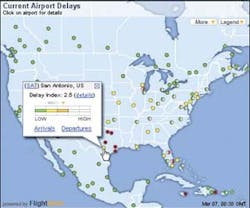A history of building commercial flight booking engines for airline carriers has now positioned the Conducive Technology Corporation well within the airport market. The FlightStats travel brand, produced by Conducive Technology, provides a data solution for airports to publish and distribute pertinent travel information to passengers in an intelligent and consistent manner using various channels of communication. Comments VP of business development Meara McLaughlin, “Our job is to make sure we get the right information to the right people, and that we never send excess information to those for whom the information isn’t relevant.”
Conducive Technology is formerly known as Sight and Sound Software, the technology company that built the first online booking engine for American Airlines back in the mid-90s, as well as for many other carriers as well, says McLaughlin.
“I have been with the company for six years … but half of the company has been here since those original days in the ‘90s; the team is seasoned and used to building mission critical systems for the aviation industry.
“FlightStats started building booking engines for airlines, were acquired, and spent three years under a non-compete; we built the platform that FlightStats is on but we could only utilize it within the air freight industry. So before we sprang from the egg wholly-formed as FlightStats in late 2005, we had already been tried by fire, and we already knew we had better real-time status information than anyone had ever produced before.”
A Data Powerhouse
FlightStats collects the critical real-time flight status data, explains McLaughlin, by starting with OAG (Official Airline Guide) schedules updated every week, then it applies to that the FAA ASDI (aircraft situational display to industry) feed; ATC (air traffic control) advisory; and weather information. “We also pull in data direct from the movement control systems of airlines as well as the airline-supplied flight information through all of the GDSs (global distribution systems) including Sabre, Amadeus, Galileo, Apollo, etc.,” she says.
“We power the information either for web display or FIDS (flight information display system) at some 100 airports. In many cases, those airports also push back to us any data that is input locally.
“We also have regional partners that work with airlines internationally to push data back to us.”
The information is better than what most airports can produce for themselves, remarks McLaughlin. “Not only does FlightStats have more data sources ... ” she says.
“The real secret sauce of our system is that we monitor and intelligently interpret all of these systems that have different standards, and are in different data formats … and often they conflict.
“We have an entire intelligence layer that interprets the information and applies data precedence to it. The goal is to be able to go back in time and look minute-by-minute at a flight — which system told us the right information? How reliable is it? And how consistent is that the case?”
What airports have to do to have this type of data can often be very time consuming, says McLaughlin. With FlightStats, an airport can be given a data drop that has all of the sources and data aggregated, everything updated minute-by-minute, and it can be dropped in for use on FIDS or a website.
The Airport Communication Challenge
“We started being contacted by airports in the U.S. because passengers were walking into terminals and standing in front of a FIDS with a mobile device and asking why the flight information display had inaccurate information while the mobile device they were holding had the correct data,” explains McLaughlin.
“The membrane that used to sort of encapsulate the sphere of interest that an airport had has been punctured. Travelers can now get better more reliable information on their own digital devices; the standard has changed.”
McLaughlin says the company didn’t start out chasing the airport market. “We had assumed airports were all set in this regard,” she relates.
“Airports found us. We have developed products, pricing, and approaches specific to the kinds of communication needs airports want solutions for.”
According to FlightStats, in publishing information through the platform’s Airport Portal web-based tool, millions of passengers are reached via airport FIDS monitors, leading smart mobile applications, leading Internet search engines including Bing and Google, automotive GPS, hotel digital signage, dozens of websites such as USA Today and those of the local media, and FlightStats.com. The FlightStats consumer website receives more than three million unique visitors per month representing more than seven million visits.
“We get 30 to 40 million visitors per month on our free consumer site,” says McLaughlin. “We also power Google — Googling any active flight number will give you a weblink to my data, the FlightStats website. Anywhere you see flight status data, if you scratch the surface just a little bit, you will find FlightStats.”
So, where’s the traveler going to go to get the information they need, asks McLaughlin? That’s where the airport has to make sure its information is distributed, she says.
“The data is correct … often more accurate than what airports are spending money on trying to create themselves by whittling pieces of information systems together,” explains McLaughlin.
In addition, it has the ability to generate revenue because it adds site ‘stickiness’, she says. Revenue can be generated with partner ads or affiliate programs an airport might have. Airports can imbed vendor advertising or their own advertising into the FlightStats Web applications.
The Sales Model
“If an airport wants my flight information on their website,” says McLaughlin, “I have a free widget for that. Any airport in the world can put this information on their website for free.”
For example, the FlightStats Airport Tracker application, which displays all of the inbound and outbound aircraft at a particular airport, is free because it includes FlightStats advertising, and the airport brands the application.
“As a user, once in an application such as Flight Tracker, everything after the first look (more detailed information) will take the user back to the FlightStats website,” says McLaughlin. “We give airports a great set of features, but then at a point we are going to try and monetize it.
“Essentially, if the user drills into the flight data on an airport’s website a third time, they will be directed to the FlightStats webpage.”
Another option is the paid model, relates McLaughlin. Airports can pay $5 for 1,000 queries — for most airports the price will be $50 for 50,000 queries and the user is not redirected away from the airport website.
“Boston and Dallas are already using us to push flight alerts,” says McLaughlin. “You can push branded flight alerts to individual travelers. That service comes with a cost, but if you know you are capturing that customer and keeping their attention, that’s key.”
Newest Tool: Airport Portal
Portland International Airport (PDX) is the launch airport for the Airport Portal service, comments McLaughlin. The application will debut at the 2010 Airport Council International-North America (ACI-NA) annual conference held in Pittsburgh in late September.
Comments McLaughlin, “Portland has been a phenomenal partner and it continues to recognize innovative partnerships. They had been struggling with this same issue … how do you get information out effectively?
The Airport Portal is a free web-based tool that gives minute-to-minute situational flight information data to the airport.
The service provides detailed information about the status of a particular flight, and also gives an entire timeline of everything FlightStats knows, and from what source, about any active flight, explains McLaughlin. A ‘dashboard’ shows summary information on the current status of the airport, including on-time performance statistics for an airport’s top carriers, as well as an overall delay index for the airport and a map of delay indices for other airports around the country.
With regard to updating data in real-time, McLaughlin says, “We can get the airport 99 percent of the way, but occasionally in real-time, the airport might actually know more.
“If airline information is incorrect and the airport knows that, the airport can get into the system and manually adjust gate schedules, and that will inform the 40 million visits on my site, all of google, and the airport’s website, and instantly update the system.
“The goal is to identify all the kinds of information that all of the airport stakeholders and tenants have to get out into the world, and we’ve built up this system to acknowledge that.”
Airport Portal also allows authorized staff to update a variety of airport facility information, including gate mapping and services and amenities databases, and contact information as well as additional details about the airport.
TripTalk Messaging
FlightStats Airport Portal incorporates a new messaging platform from Conducive Technology called TripTalk. TripTalk allows airports to publish messages to either specific or broadly targeted audiences. For example, airports can publish construction advisory messages and target everyone who is checking flights or carrying an itinerary for a specified time range.
Additional features include:
- Publish Parking Lot Availability and Security Wait Times;
- Publish Construction, Parking, and other Advisories;
- Messages can be Targeted to Specific Travelers Based on Departure, Arrival, or Connection through the Airport; Date and Time; Airline, Flight Number, Flight Status; Connecting Times; Terminal or Gate;
- Messages Published to Entire FlightStats Network.
Says McLaughlin, “An airport can choose to have messages published to an airport’s Twitter and Facebook pages; and if the airport website and FIDS are powered by FlightStats data, the messages can display there as well.
“It’s a great partnership between FlightStats and airports. We already have all of the distribution channels; we want to help airports get the right information out there with a minimum amount of input by them.
“Airports should be able to put critical information in one place and have it go everywhere it needs to in an intelligent way.”
For more information on Flightstats, contact [email protected].
About the Author

